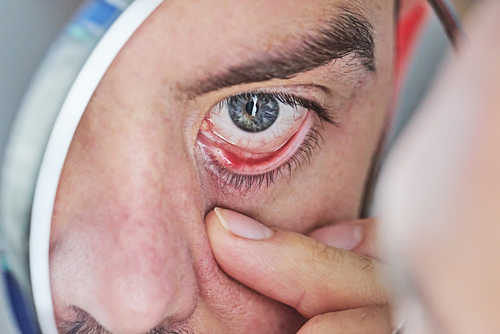
The eyelids play a vital role in protecting the eye from external injury. They help create a moist environment that ensures the normal function and health of the conjunctiva and cornea. Covered by soft skin, the eyelids have muscles that allow eye opening and closing. The inner eyelids have a mucous membrane or glands that produce mucus for the tears.
The Meibomian Glands
The upper and lower eyelid edges are kept lubricated by oil produced by the meibomian glands. The tear film consists of water, oil, and mucus layers that nourish and protect the eyes. Oil is a vital part of the tear film that reduces tear evaporation.
The eyelids contain between 20 to 40 meibomian glands, with the upper eyelids containing more. The oil produced helps coat the eyes, keeping them healthy and well-lubricated.
Meibomian Gland Dysfunction
Meibomian gland dysfunction (MGD) is a condition characterized by the failure of the glands to produce adequate oil (meibum). It is a common cause of dry eye syndrome and can also cause blepharitis.
MGD occurs when the meibomian glands are blocked, preventing the normal flow of oil. It reduces tear quantity and affects the quality of tears produced, which can irritate. MGD usually does not have symptoms in the early stages.
Dry Eye Syndrome
Dry eye is a condition caused by the failure of the eyes to produce adequate or good-quality tears. Various factors can cause dry eye, but one of the most common causes is MGD. When the meibomian glands are clogged or blocked, it affects oil secretion, leading to dry eye.
The risk of developing dry eye increases as people age. Women who regularly wear eye makeup have an increased risk of developing dry eye from MGD.
Symptoms of MGD
The common symptoms of meibomian gland dysfunction include:
A burning sensation.
Extreme eye dryness.
Foreign body sensation.
Redness.
Eye itching.
Excessively watery eyes.
Crusty eye discharge.
Blurry vision.
Light sensitivity.
Styes/chalazion.
Diagnosing MGD
Your eye doctor will perform a thorough eye exam to determine if you have MGD. Applying pressure to the eyelid will allow your eye doctor to examine the expressed secretions. The exam will include evaluating tear quantity, quality, and stability. A tear breakup time (TBUT) test helps determine tear film stability. The test involves the use of dye to examine how quickly the tears break up.
Treating MGD
There are various treatments for MGD. They include:
LipiFlow® therapy helps open the meibomian glands, improving oil production.
Intense pulsed light (IPL) therapy that reduces inflammation and growth of bacteria.
iLUX® helps melt waxy secretions that build up, blocking the glands.
TearCare® procedure involves the application of heating patches to unclog the glands.
Lid debridement helps clean debris from the eyelids.
BlephEx® helps exfoliate the eyelids, eliminating debris and opening the glands.
Steroid eye drops are often prescribed to reduce inflammation and improve tear flow.
Restasis prescription eye drops are prescribed to treat severe dry eye symptoms.
Omega-3 supplements can help reduce the risk of MGD. The fatty acids reduce inflammation associated with the condition and reduce the development of debris.
For more on the role of meibomian gland dysfunction in dry eye, contact Patel Vision Group at one of our 8 convenient locations in Visalia, Fair Oaks, Fresno, Redding, Roseville, Sacramento, Monterey, and Salinas, California. Call (559) 739-8550, (916) 966-4700, (559) 229-7955, (530) 221-6557, (916) 788-2960, (916) 629-8033, (831) 375-7755, or (831) 443-5250 to discuss your questions or schedule an appointment today.








